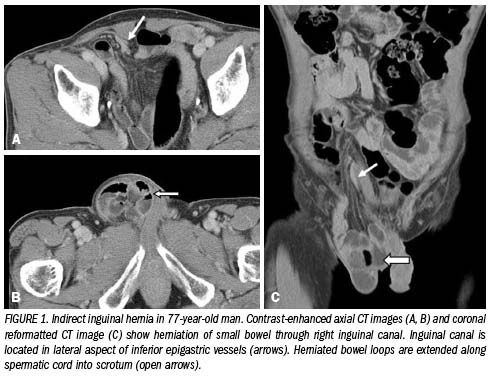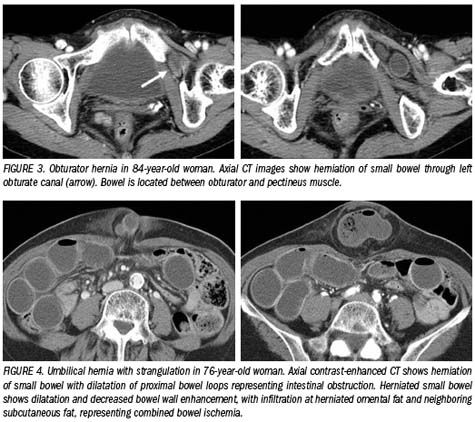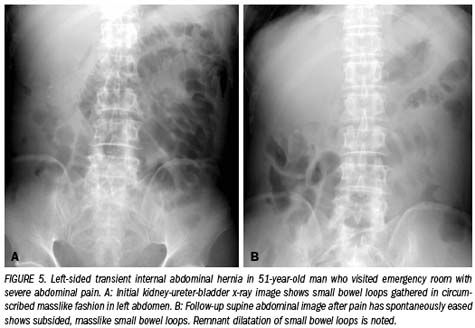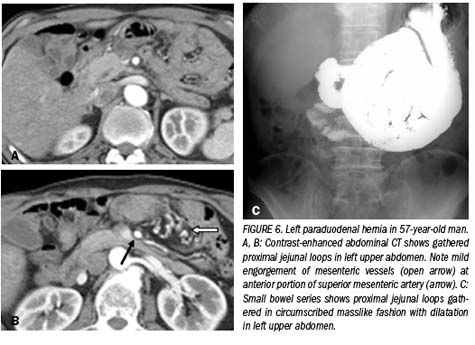Multidetector CT reveals diverse variety of abdominal hernias
Although most hernias involving the anterior abdominal wall or groin can be diagnosed easily by inspection and palpation, imaging is the principal means of detecting internal, diaphragmatic, and other nonpalpable or unsuspected hernias.1,2
Although most hernias involving the anterior abdominal wall or groin can be diagnosed easily by inspection and palpation, imaging is the principal means of detecting internal, diaphragmatic, and other nonpalpable or unsuspected hernias.1,2
Multidetector CT can reveal the precise anatomic site of the hernia sac, the contents of the sac, and any complications. These features are critical to the initial diagnosis and subsequent management of the condition. 3 The multiplanar capability of MDCT also offers exquisite detail of the abdominal wall, allowing wall hernias to be identified accurately.4
An abdominal hernia can be classified into one of three types. An external hernia (abdominal wall hernia) is caused by the prolapse of an intestinal loop, omentum, or mesentery through a defect in the wall of the abdomen and/or pelvis. An internal hernia involves the protrusion of the bowel through the omentum or mesentery and into a compartment in the abdominal cavity. A protrusion of the stomach, bowel, omentum, or mesentery into the chest is usually described as a diaphragmatic hernia.
Intestinal obstruction is the most common complication caused by hernia. It is observed on CT as the dilatation of proximal bowel loops, together with a reduced or collapsed bowel caliber distal to the obstruction. Incarceration refers to an irreducible hernia; that is, the hernia cannot be reduced or pushed back manually. This diagnosis may be made clinically. A strangulating small bowel obstruction, which occurs after a closed loop obstruction, may be identified on CT from wall thickening, engorgement of mesenteric vessels, mesenteric haziness, and ascites.5
ABDOMINAL WALL HERNIAS
Wall hernias are a common finding on abdominal imaging. Most abdominal wall hernias are asymptomatic, though they may cause acute complications that require emergency surgery. Prompt diagnosis is desirable, as delays in treatment are linked to significant morbidity.6 To avoid the chance of acute complications, this type of hernia will usually be repaired as an elective surgical procedure.7

• Inguinal hernia. Inguinal hernia, the most common type of abdominal hernia, may be subdivided further into indirect and direct inguinal hernias. Indirect inguinal hernias, which are found more often, occur lateral to the inferior epigastric vessels (Figure 1). They are observed in male children when the peritoneal extension accompanying the testis during embryonic development is not obliterated completely, and can form in adults owing to weakness and dilatation of the inguinal canal.8
Direct inguinal hernias, which are seen less frequently, are found medial to the inferior epigastric vessels. They are caused by acquired weakness of the transversalis fascia and are more common in older patients.
• Femoral hernia. Femoral hernias are less common than inguinal hernias and are more likely to be seen in female patients. They occur medial to the femoral vein, which is also compressed by the hernia. These findings are used to differentiate femoral hernias from inguinal hernias on CT (Figure 2).9

• Obturator hernia. Obturator hernias are uncommon. The site of hernia is the obturator canal in the superolateral aspect of the obturator foramen, through which the obturator nerve and vessels course. The herniated bowel loops are located between the pectineus muscle and the obturator muscle (Figure 3).10 Approximately 80% to 90% of these hernias occur in elderly women. They are most likely to be due to enlargement of the obturator canal after pregnancy and the aging process.3
• Ventral hernia. All hernias in the anterior and lateral abdominal wall are referred to as ventral hernias. Midline defects include umbilical, paraumbilical, epigastric, and hypogastric hernias. Umbilical hernias (Figure 4) are the most common type, and these tend to be seen in women. Paraumbilical hernias are large abdominal defects through the linea alba. Epigastric and hypogastric hernias occur in the linea alba above and below the umbilicus.
Spigelian and lumbar hernias are both types of lateral ventral hernia. Spigelian hernias are uncommon and occur in the anterolateral aspect of the lower abdominal wall owing to congenital weakness in the posterior wall of the transversalis fascia. Lumbar hernias are caused by defects in the lumbar muscles or the posterior fascia below the 12th rib and above the iliac crest. They usually occur after surgery or trauma.
• Incisional hernia. Incisional hernias are delayed complications that arise in the first few months after abdominal surgery. They are more often associated with vertical incisions than transverse incisions.1 Parastomal hernias, a subtype of incisional hernia, occur adjacent to a stoma.
INTERNAL HERNIAS
Internal hernias may be included in the differential diagnosis in cases of intestinal obstruction. The responsible hernial orifices are usually preexisting anatomic structures, such as foramina and fossae. The pathologic defects of the mesentery and visceral peritoneum, which are caused by congenital mechanism, surgery, and trauma, are also potential herniation orifices.11 The locations and relative frequencies of internal hernias are as follows: paraduodenal (53%), pericecal (13%), foramen of Winslow (8%), transmesenteric (8%), sigmoid mesocolon (6%), and retroanastomotic (5%).3


Internal hernias are silent if they are easily reducible, but the majority often cause epigastric pain and recurrent episodes of intestinal obstruction (Figure 5). These hernias are clinically apparent when incarcerated internal hernia result from small bowel obstruction. A delay in diagnosis may consequently lead to strangulation and increase the risk of serious complications. Several factors may be helpful when making a preoperative diagnosis of internal hernia with CT. These include knowledge of the normal anatomy of the peritoneal cavity and the characteristic anatomic location of each hernia, observation of a saclike mass or a cluster of dilated small bowel loops at an abnormal anatomic location, and the observation of engorged and converging vessels at the hernial orifice.12

Paraduodenal hernia. Paraduodenal hernias are the most common type of internal hernia. They are more often seen in men than in women. Approximately 75% occur on the left side.13 Left paraduodenal hernias develop through the fossa of Landzert, which is located at the duodenojejunal junction. CT reveals an abnormal clustered or saclike mass of small bowel loops lying between the stomach and pancreas (Figure 6). Right paraduodenal hernias involve the fossa of Waldeyer, which is located behind the superior mesenteric artery and inferior to the transverse portion of the duodenal loop (Figure 7).
Transmesenteric hernia. The small bowel mesentery is a broad, fan-shaped fold of peritoneum that suspends the small bowel from the posterior abdominal wall. The two layers of peritoneal reflection form the mesentery, which extends from its origin at the ligament of Treitz to the ileocecal valve.13 Transmesenteric hernias are probably caused by a congenital mechanism. Defects are located close to the ligament of Treitz or the ileocecal valve.4,14
Transmesenteric hernias are usually associated with mechanical obstruction due to the absence of a limiting hernia sac.4,15
Foramen of Winslow hernia. In this type of hernia, the lesser sac comes into communication with the greater sac through the foramen of Winslow, which is located anterior to the inferior vena cava and posterior to the hepatoduodenal ligament.4,13 The small bowel is the herniated segment in about 60% to 70% of cases, and the terminal ileum, cecum, and the ascending colon are involved in about 25% to 30% of cases.13 An aberrant position of bowel loops between the liver, stomach, and pancreas will be seen on MDCT.
In conclusion, anatomic structures in the abdomen can be delineated clearly on MDCT images. A good understanding of the likely anatomic location of each type of hernia and an appreciation of characteristic CT findings will consequently help when diagnosing abdominal hernias. Radiologists should be aware of the nature of complications that can arise from abdominal hernias and offer appropriate guidance to clinicians. Optimized treatment planning should avoid irreversible damage to the bowel wall and mesentery.
Assisting in the preparation of this manuscript were Dr. Jang Gyu Cha and Prof. Hyun Sook Hong, radiologists from Soonchunhyang University Bucheon Hospital.
Meta-Analysis Shows Merits of AI with CTA Detection of Coronary Artery Stenosis and Calcified Plaque
April 16th 2025Artificial intelligence demonstrated higher AUC, sensitivity, and specificity than radiologists for detecting coronary artery stenosis > 50 percent on computed tomography angiography (CTA), according to a new 17-study meta-analysis.
The Reading Room: Racial and Ethnic Minorities, Cancer Screenings, and COVID-19
November 3rd 2020In this podcast episode, Dr. Shalom Kalnicki, from Montefiore and Albert Einstein College of Medicine, discusses the disparities minority patients face with cancer screenings and what can be done to increase access during the pandemic.
Could Lymph Node Distribution Patterns on CT Improve Staging for Colon Cancer?
April 11th 2025For patients with microsatellite instability-high colon cancer, distribution-based clinical lymph node staging (dCN) with computed tomography (CT) offered nearly double the accuracy rate of clinical lymph node staging in a recent study.